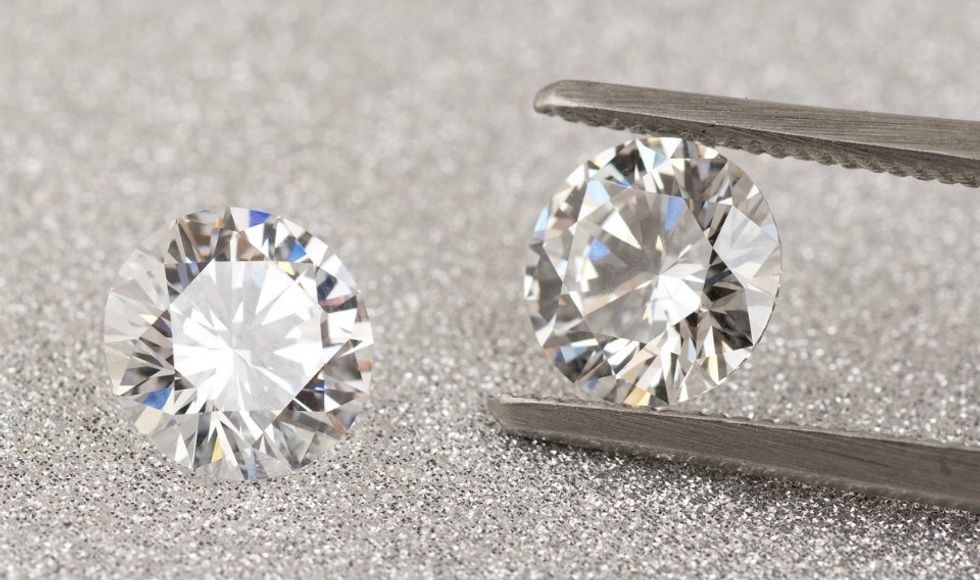The topic of man made diamonds is raising today with the incredible periodicity. Most likely, you have already read the myriad of optimistic statements concerning the unquestionable positive ecological, economic and aesthetical effects from your responsible choice in favor of lab-created gemstones.
We are sure, you could not help questioning each of these claims. We are sure because we believe that each coin has two sides and it is crucially needed to look behind the front beautiful side and only then decide. So, we have monitored the reverse side of positivism and tried to think whether it indeed matters. Here are our considerations.
1. The marketers present lab-grown diamonds as a totally eco-friendly jewelry item. However, we dare to ask how much energy the companies should use to produce the analog of natural diamonds in laboratories and what amount of carbon gases this process could generate.
Indeed, the process of lab-grown diamonds requires a significant energetic potential since high temperature is the core factor in replicating the natural conditions. There is a true challenge for companies who bet on man made stones. In the present moment, it is very difficult to evaluate true harm but one can see two possible courses of events. The first one: enterprises will use the traditional way of generating energy what, without any saying, enhance existing ecological problems in the case of growing demand on lab-grown diamonds. Indeed, it is worth saying that this seemingly threatening way of production is more eco-friendly than mining.
Another way (best possible one): being guided by ecological awareness, the companies will gradually pass to eco-friendly sources of energy. Then, we have the chances to identify lab-created diamonds as an environmentally safe option.
2. Economic profit is also among the primary optimistic arguments for synthesized diamonds. Yes, the consumers could buy the lab-grown diamonds cheaper, but what about those people from developing countries where the natural diamonds are mined? They will lose their workplaces and the potential source nurturing the economy. Due to statistic data, the issue touches around 10 million people in the world. Is it justified?
If you think from this perspective, be calm. There are already numerous compensation instruments. The global community is ready to finance these countries to enable them to restore the earth and mitigate social risks. Moreover, the transition from the traditional way of mining to synthesizing would not happen in a minute at least because of the low current demand. Thus, gradual moving towards innovative technique will provide the time for replacing the niche, which is not actual anymore, with new kinds of activity and new workplaces as well.
We should also say, that society will unlikely refuse from natural diamonds at all. It is a well-known fact that despite their multiple advantages, lab-created diamonds do not have the investment value while investing is a vital economic activity, which will continue to generate demand on natural gemstones.
3. The similarity of aesthetic value is one more claim in favor of responsible for choosing the lab-grown diamonds. We forget about the true meaning of aesthetic. It is not merely external beauty but intangible associations ascribed to the gemstones making people feel special. Although this counterargument could seem weak for rational persons, we know exactly what the spiritual value matters a lot.
So, what can we say concerning this? If you belong to those for whom metaphysical issues are significant, you, most likely, have the potent abilities on self-programing. So, even lab-grown diamonds could be a sign of status, individual force, identity or success-generating items for you. All you need – to reshape your vision of gemstones' influence and value.
Summing up, we can conclude that any innovation could and should be challenged. However, without innovative decisions the progress is impossible. So, we should give the chance for developing the practice of creating diamonds in laboratory conditions but, at the same time, we should control this process through being curious and responsible consumers!
About the author: independent writer, analytic of jewelry trends exploring the innovative IstoriaJewellers policy.



 Photo by
Photo by  person holding black smartphone on white textile
Photo by
person holding black smartphone on white textile
Photo by  StableDiffusion
StableDiffusion
 Photo by
Photo by  Photo by
Photo by 
 roommate as a therapist
StableDiffusion
roommate as a therapist
StableDiffusion
 woman in white shirt eating pizza
Photo by
woman in white shirt eating pizza
Photo by  person holding remote pointing at TV
Photo by
person holding remote pointing at TV
Photo by  person holding assorted clothes in wooden hanger
Photo by
person holding assorted clothes in wooden hanger
Photo by  a couple of
a couple of  friends cleaning apartment
StableDiffusion
friends cleaning apartment
StableDiffusion
 man driving car during golden hour
Photo by
man driving car during golden hour
Photo by  bacon strips and melted cheese topped fries on oval white and blue platter with gray stainless steel forks
Photo by
bacon strips and melted cheese topped fries on oval white and blue platter with gray stainless steel forks
Photo by  selective focus photography of eyeshadow palette
Photo by
selective focus photography of eyeshadow palette
Photo by  brown wooden framed white padded chair in between green indoor leaf plants inside bedroom
Photo by
brown wooden framed white padded chair in between green indoor leaf plants inside bedroom
Photo by  women forming
women forming  taking
taking  man in red polo shirt pouring wine on clear wine glass
Photo by
man in red polo shirt pouring wine on clear wine glass
Photo by  woman in black jacket standing on road during daytime
Photo by
woman in black jacket standing on road during daytime
Photo by 
 StableDiffusion
StableDiffusion
 StableDiffusion
StableDiffusion
 student thinking i shouldnt have procrastinated all semester
StableDiffusion
student thinking i shouldnt have procrastinated all semester
StableDiffusion
 Photo by
Photo by  Photo by
Photo by  Photo by
Photo by  StableDiffusion
StableDiffusion
 StableDiffusion
StableDiffusion
 Photo by
Photo by  Photo by
Photo by 


 Lumiere figure at the Disney Store at the Ala Moana Shoppi… | Flickr
Lumiere figure at the Disney Store at the Ala Moana Shoppi… | Flickr








 StableDiffusion
StableDiffusion StableDiffusion
StableDiffusion 10. Extra BlanketsJuwenin Home 100% Cotton Knitted Throw Blanket
10. Extra BlanketsJuwenin Home 100% Cotton Knitted Throw Blanket StableDiffusion
StableDiffusion StableDiffusion
StableDiffusion File:Kishlaru familie.jpg - Wikimedia Commons
File:Kishlaru familie.jpg - Wikimedia Commons Photo by Hanna Balan on Unsplash
Photo by Hanna Balan on Unsplash StableDiffusion
StableDiffusion black blue and yellow round illustrationPhoto by
black blue and yellow round illustrationPhoto by 









